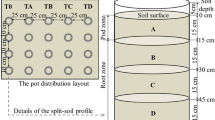Abstract
The efficiency of phytoextraction is limited because of the low growth exhibited by plants under the stress of heavy metals. Impatiens (Impatiens walleriana) cuttings were grown in soils artificially contaminated with cadmium (Cd) and modified with chemical fertilizer to study the relationship among the leaf area, transpiration rate, and Cd accumulation. The subcellular distribution of Cd in various impatiens organs was also measured. Experimental results showed that there were positive, linear relationships between the leaf area and the transpiration rate. A similar relationship was found between the transpiration rate and the Cd accumulation in the shoots. Suitable management practices can be conducted to increase the transpiration rate and thus the plant’s phytoextraction efficiency. In the roots and leaves, Cd was mainly compartmentalized in the soluble fraction and the cell wall fraction, respectively. The varied subcellular distribution of Cd in the different organs was responsible for the high accumulation capacity.








Similar content being viewed by others
References
Allen, D. L., & Jarrell, W. M. (1989). Proton and copper adsorption to maize and soybean root cell walls. Plant Physiology, 89, 823–832.
Baker, A. J. M., McGrath, S. P., Reeves, R. D., & Smith, J. A. C. (2000). Metal hyperaccumulator plants: a review of the ecology and physiology of a biological resource for phytoremediation of metal-polluted soils. In N. Terry & G. Bañuelos (Eds.), Phytoremediation of contaminated soil and water (pp. 85–107). Boca Raton, FL: CRC Press, LLC.
Blaylock, M. J., Salt, D. E., Dushenkov, S., Zakharova, O., Gussman, C., Kapulnik, Y., Ensley, B. D., & Raskin, I. (1997). Enhanced accumulation of Pb in Indian mustard by soil-applied chelating agents. Environmental Science and Technology, 31, 860–865.
Chen, H. S., Huang, Q. Y., Liu, L. N., Cai, P., Liang, W., & Li, M. (2010). Poultry manure compost alleviates the phytotoxicity of soil cadmium: influence on growth of pakchoi (Brassica chinensis L.). Pedosphere, 20, 63–70.
Ernst, W. H. O. (2005). Phytoextraction of mine wastes—options and impossibilities. Chemie der Erde-Geochemistry, 65, 29–42.
He, S. Y., Wu, Q. L., & He, Z. L. (2013). Effect of DA-6 and EDTA alone or in combination on uptake, subcellular distribution and chemical form of Pb in Lolium perenne. Chemosphere, 93, 2782–2788.
Jarvis, M. D., & Leung, D. W. M. (2001). Chelated lead transport in Chamaecytisus proliferus (L.f.) link ssp. Proliferus var. palmensis (H. Christ): an ultrastructural study. Plant Science, 161, 433–441.
Lai, H. Y., Juang, K. W., & Chen, Z. S. (2010). Large-area experiment on uptake of metals by twelve plants growing in soils contaminated with multiple metals. International Journal of Phytoremediation, 12, 785–797.
Lasat, M. M., Baker, A. J. M., & Kochian, L. V. (1996). Physiological characterization of root Zn2+ absorption and translocation to shoots in Zn hyperaccumulator and nonaccumulator species of Thlaspi. Plant Physiology, 112, 1715–1722.
Lin, C. C., Lai, H. Y., & Chen, Z. S. (2010). Bioavailability assessment and accumulation by five garden flower species grown in artificially cadmium-contaminated soils. International Journal of Phytoremediation, 12, 454–467.
Liu, X. Q., Peng, K. J., Wang, A. G., Lian, C. L., & Shen, Z. G. (2010). Cadmium accumulation and distribution in population of Phytolacca americana L. and the role of transpiration. Chemosphere, 78, 1136–1141.
Luo, C., Shen, Z., Li, X., & Baker, A. J. M. (2006). Enhanced phytoextraction of Pb and other metals from artificially contaminated soil through the combined application of EDTA and EDDS. Chemosphere, 63, 1773–1784.
Qiu, Q., Wang, Y., Yang, Z., & Yuan, J. (2011). Effects of phosphorus supplied in soil on subcellular distribution and chemical forms in two Chinese flowering cabbage (Brassica parachinensis L.) cultivars differing in cadmium accumulation. Food and Chemical Toxicology, 49, 2260–2267.
Salt, D. E., Prince, R. C., Pickering, I. J., & Raskin, I. (1995). Mechanisms of cadmium mobility and accumulation in Indian mustard. Plant Physiology, 109, 1427–1433.
Shi, G. G., & Cao, Q. S. (2009). Leaf plasticity in peanut (Arachis hypogaea L.) in response to heavy metal stress. Environmental and Experimental Botany, 67, 112–117.
Sun, Y. B., Zhou, Q. X., Wang, L., & Liu, W. T. (2009). Cadmium tolerance and accumulation characteristics of Bidens pilosa L. as a potential Cd-hyperaccumulator. Journal of Hazardous Materials, 161, 808–814.
Wang, X., Liu, Y. G., Zeng, G. M., Chai, L. Y., Song, X. C., Min, Z. Y., & Xiao, X. (2008). Subcellular distribution and chemical forms of cadmium in Bechmeria nivea (L.) Gaud. Environmental and Experimental Botany, 62, 389–395.
Wei, J. L., Lai, H. Y., & Chen, Z. S. (2012). Chelator effects on bioconcentration and translocation of cadmium by hyperaccumulators Tagetes patula and Impatiens walleriana. Ecotoxicology and Environmental Safety, 84, 173–178.
Wójcik, M., Vangronsveld, J., D’Haen, J., & Tukiendorf, A. (2005). Cadmium tolerance in Thlaspi caerulescens: II. Localization of cadmium in Thlaspi caerulescens. Environmental and Experimental Botany, 53, 163–171.
Wu, F. B., Dong, J., Qian, Q. Q., & Zhang, G. P. (2005). Subcellular distribution and chemical form of Cd and Cd-Zn interaction in different barley genotypes. Chemosphere, 60, 1437–1446.
Xu, D., Chen, Z., Sun, K., Yan, D., Kang, M., & Zhao, Y. (2013). Effect of cadmium on the physiological parameters and the subcellular cadmium localization in the potato (Solanum tuberosum L.). Ecotoxicology and Environmental Safety, 97, 147–153.
Zhu, Q. H., Huang, D. Y., Liu, S. L., Luo, Z. C., Rao, Z. X., Cao, X. L., & Ren, X. F. (2013). Accumulation and subcellular distribution of cadmium in remie (Boehmeria nivea L. Gaud.) planted on elevated soil cadmium contents. Plant, Soil and Environment, 59, 57–61.
Acknowledgment
This research was sponsored by the National Science Council of Taiwan under grant no. NSC 102-2313-B-451-003.
Conflict of Interest
The author declares that there is no conflict of interest regarding the publication of this paper.
Author information
Authors and Affiliations
Corresponding author
Rights and permissions
About this article
Cite this article
Lai, HY. Effects of Leaf Area and Transpiration Rate on Accumulation and Compartmentalization of Cadmium in Impatiens walleriana . Water Air Soil Pollut 226, 2246 (2015). https://doi.org/10.1007/s11270-014-2246-9
Received:
Accepted:
Published:
DOI: https://doi.org/10.1007/s11270-014-2246-9




